#Dasyurus
Note
Heya I'm bored so like, what's yoir current favorite animal? Mines the olm
Ahhhh I love them all it's hard to choose... Sooo I'll say my top 2
The spotted tiger Quoll
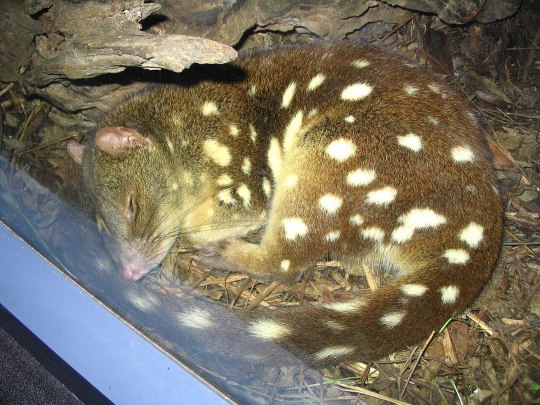
(Pictured: A spotted tiger quoll, Dasyurus maculatus, curled up sleeping in a glass exhibit.)
Bunjeen is the original Indigenous name (from the Bandjalung language group) for them in my area. Was called the marsupial cat by colonizers until naturalist told folk or was missleading. "Quoll" comes from anglicisation of "dhigul" (Note: Aboriginal spelling is different from English spelling) from the Guugu Yimithirr mob who contacted Captain Cook (our Christopher Columbus booooo).
Since it occupies the same ecological niche as them. A good native defence against feral rabbits, but is vulnrable due to competition with feral cats and poisoning from cane toads. These Polka dotted murder balls are the second largest extant carnivorus marsupial. Live only for 2-4 years. The size of a grain of rice when born. Live solitarily, but will use a communal latrine to see who's in the area. Reaches it's teens in year one, stops growing year two, doesn't live very long past year 3 (;TДT). I don't like exotics, and the reality is definetly different to my fantasy, but I kinda want one as a pet. Maybe I can volunteer at a sanctuary or something.
(Pictured; A Spotted-tailed Tiger Quoll on a mossy log at night, by JJ Henson.
Below that picture is an Eastern Quoll, Dasyurus viverrinus. Eating a very bloody piece of meat with their hands full. I had to include it for the absolute gremlin energy).
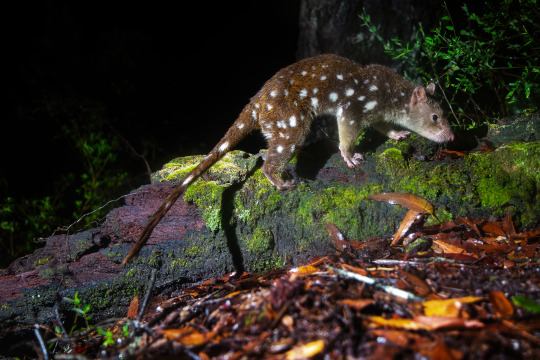

Hoatzin
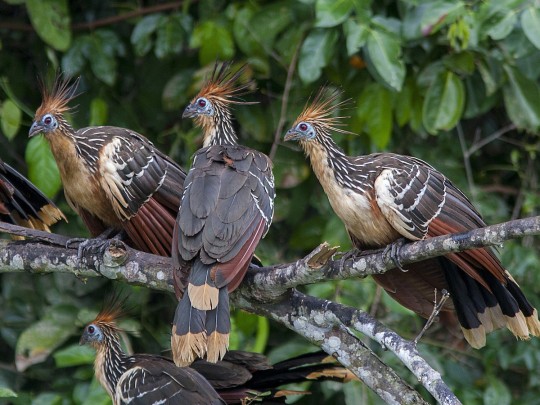
Stem-bird/Dinosaur vibes. Babies have claws on their wings to climb trees if they fall out of the nest. It is also the only bird to be a folivore; a dedicated leaf eater (foli, like foliage, and vore, which I encourage everyone to look up themselves). It's very rotund for digestion and stinky, like a cow! A dinosaur cow bird is also apt, because we no idea what kind of bird it is! Is it a pheasant? Ratite? Songbird? To my understanding, the current idea is that it's a survivor of a unique lineage of birds that survived the Chicxulub mass extinction. Our oldest fossils of potential relatives only go to about 30 MYA. Not even genetics have gotten us too far, but give it time. Was my profile picture for a time on an obscure internet forum when I was a teen. It is also the same colours as my favourite and oldest Velociraptor plush toy. (Razor the wild republic UK Velociraptor plush)


(Pictured; Top Picture of a Hoatzin chick with visable wing claws. Below it Razor, my Willd Republic UK Velocirptor)
#Bandjalung#Bandjalung language#Indigenous languages#Aboriginal language#Inidgenous language#Aboriginal Australia#Bunjeen#tiger quoll#spotted-tail quoll#Dasyurus maculatus#Quoll#Dasyurus#marsupial#mammal#Hoatzin#Opisthocomus hoazin#Opisthocomus#aves#birds#metazoa#animals#plush#Wild republic#wild republic velociraptor#plushies#velociraptor#This was meant to be a quick summery but I spent 3 hours doing background research on these guys woops
7 notes
·
View notes
Photo

An Eastern quoll (Dasyurus viverrinus) scavenging in Tasmania, Australia
by David Chesterfield
#eastern quoll#quolls#marsupials#dasyurus viverrinus#dasyurus#dasyuridae#Dasyuromorphia#marsupialia#mammalia#chordata#wildlife: tasmania#wildlife: oceania
30 notes
·
View notes
Text
Demure asian schoolgirl enjoys coarse gang bang sex
Super hot lesbians enjoying hardcore massage
MISS MILLER (JASMINE) GETS HER PUSSY POUNDED IN CLASS
Blonde lesbian pussy sucking
village Indian desi bhabhi pussy sex game
Milf safada gozando na siririca
Cute redhead teen with freckles POV suck and fuck Hardcore
PURE TABOO Eliza Ibarra & Maya Kendrick Fuck Their Professor To Stay Out Of Trouble
Animated porn music and sex dance Ryder Skye in Stepmother Sex
Super sexy teens are into threesomes with one impressive guy
#bionditional#Dasyurus#stellatrix#pumices#two-light#unviable#rhatania#vestibulo-urethral#subset#Terbecki#dermophyte#Bassa#Arauan#self-formed#directexamination#Euchlaena#gardeny#Orlon#conicalness#shikaris
0 notes
Note
One 🥚, please. Thank you!


eastern quoll!
(Dasyurus viverrinus)
83 notes
·
View notes
Text

Albino Northern quoll (Dasyurus hallucatus) [x]
#albino#albinism#northern quoll#quoll#Dasyurus hallucatus#marsupial#mammal#award for albino with most red eyes goes to this guy#it’s like solid red marbles
734 notes
·
View notes
Photo
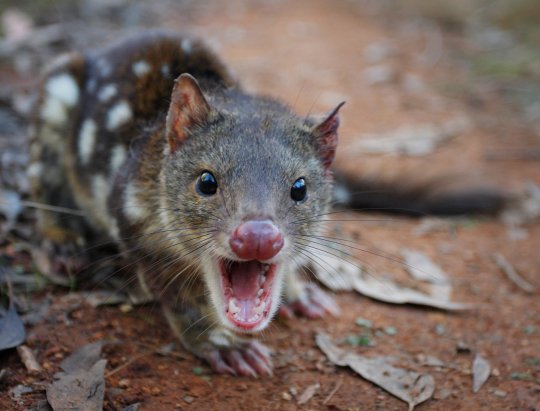
Spotted-tailed Quoll (Dasyurus maculatus).
Image credit: Avalon.red / Alamy Stock Photo
#avalon.red#photographer#alamy stock photo#spotted-tail quoll#dasyurus maculatus#animal#quoll#mammal#australian geographic#nature#wildlife
91 notes
·
View notes
Text
Limestone Coast district ranger Ross Anderson said NPWS was "blown away" by the animal's re-emergence in the state after 130 years.
[…]
"There's been some anecdotal, verbal records in the 1970s and 1980s of local sightings, but the last official records of spotted-tailed quolls are from the 1880s," Mr Anderson said.
"There's been no official documented or photographic evidence of them here for over 100 years."

#spotted–tailed quoll#tiger quoll#animals#mammals#marsupials#australian marsupials#quolls#s o: australipelphia#o: dasyuromorphia#f: dasyuridae#s f: dasyurinae#tr: dasyuruni#g: dasyurus#sp: d. maculatus#conservation#extinct species
0 notes
Text
It is possible that some individuals in these species engage exclusively in same-sex behavior, while others may be bisexual, but little is known about the life histories of specific individuals.
"Biological Exuberance: Animal Homosexuality and Natural Diversity" - Bruce Bagemihl
#book quote#biological exuberance#bruce bagemihl#nonfiction#fat tailed dunnart#sminthopsis crassicaudata#northern quoll#dasyurus hallucatus#bisexual
0 notes
Text
Fat-tailed Dunnarts often live together in small groups or pairs that share nests; these groupings are temporary and may consist of individuals of the same sex (especially outside the breeding season). Although little is known about the social system of Northern Quolls, it appears that most individuals are largely solitary.

"Biological Exuberance: Animal Homosexuality and Natural Diversity" - Bruce Bagemihl
#book quotes#biological exuberance#bruce bagemihl#nonfiction#fat tailed dunnart#sminthopsis crassicaudata#northern quoll#dasyurus hallucatus#social system#solitary
0 notes
Text

from parasitologist mackenzie kwak: “ The burrowing flea (Uropsylla tasmanica) is the only ectoparasite species recorded from the thylacine, though only a single adult flea was ever collected (from an individual that was shot near Launceston (Tasmania) in 1879)! Fortunately, these fleas are also found on Tasmanian devils (Sarcophilus harrisii) and quolls (Dasyurus spp.) and survive to this day despite the last known thylacine dying in the Hobart zoo back in 1933. “
If we actually de-extincted the thylacine their fleas would still be waiting for them :)
392 notes
·
View notes
Text

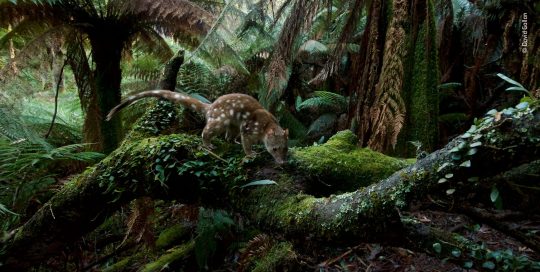
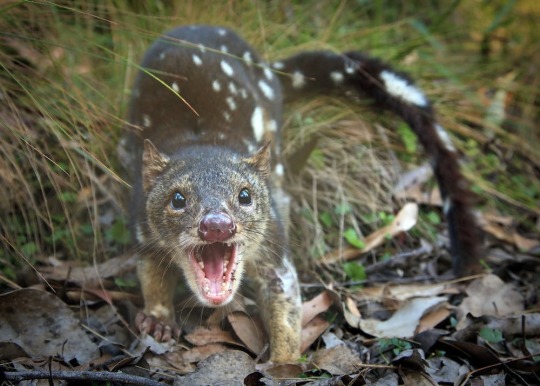
Australian Marsupials - Tiger Quoll / Spotted Tail Quoll
Dasyurus maculatus
Status: Near Threatened
Range: Eastern Australia and Tasmania
Diet: Carnivorous
#australia#marsupials#australian animals#quoll#spotted quoll#nature#animals#image sources and credits are hyperlinked!#idk I had this brainworm to show you guys some weird marsupial once a week#that you probably don't know about#will I keep up the habit? arguable#but I will try#wikipedia is linked - I'd write more of a thing but if I'm actually gonna keep doing it this is probably the better way#anyway quolls are the shit#straya
19 notes
·
View notes
Text
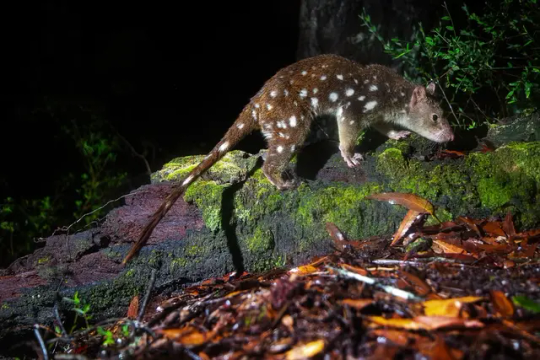
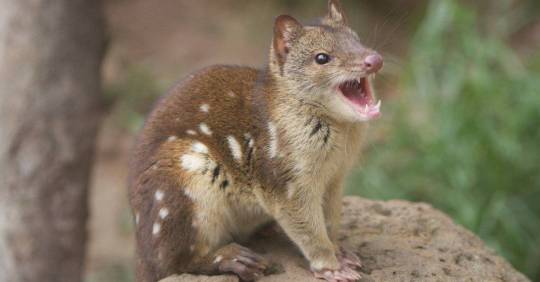
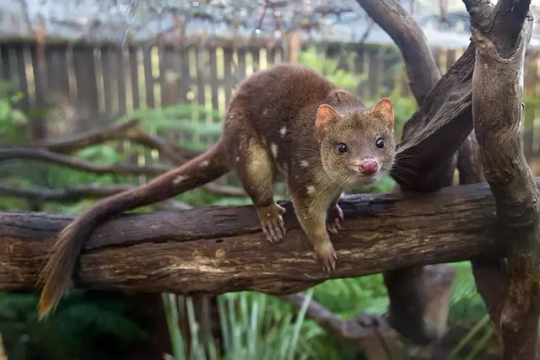
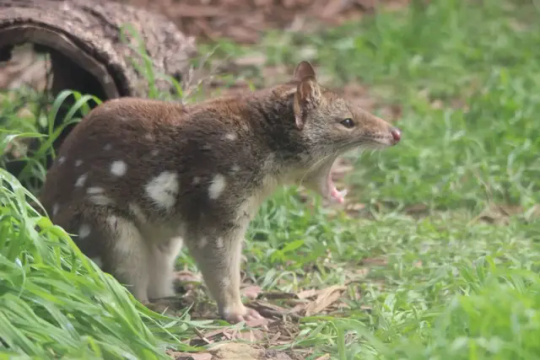
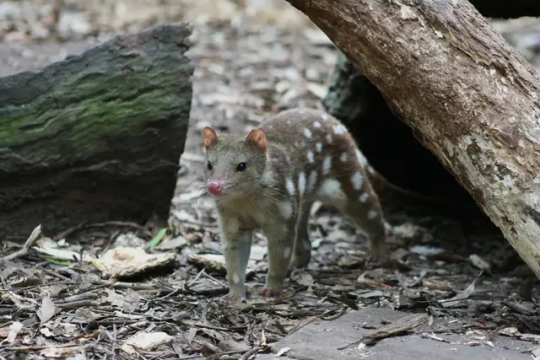

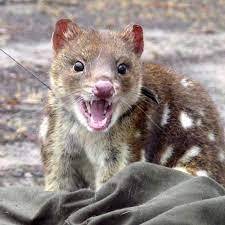

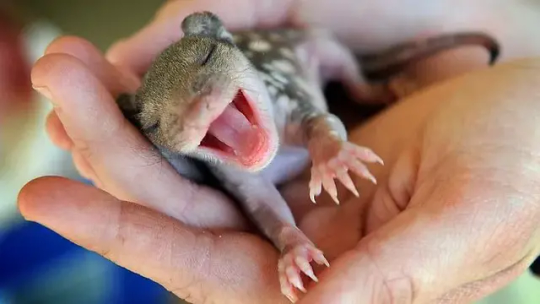
Dasyurus maculates, better known as the tiger quoll, the spotted-tail quoll, the spotted quoll, the spotted-tail dasyure, native cat or the tiger cat, is a carnivorous marsupial native to eastern and southern Australia and the island of Tasmania. These semi-arboreal mammals can be found in a variety of habitats including mixed dry and alpine forests, pastureland, and grasslands, but seem to prefer wetter environments such as riverine forests, rainforests and closed eucalypt forest. Tiger quolls are generally nocturnal, spending there days in dens they build in burrows, caves, rock crevices, tree hollows, hollow logs, or abandoned buildings. They emerge at night to hunt prey such as insects, crustaceans, lizards, snakes, frogs, birds, platypus, echidnas, rabbits, possums, cuscuses, gliders, bandicoots, pademelons, small wallabies, and wombats. Tiger quolls are themselves preyed upon by Tasmanian devils, masked owls, dingos, large pythons, and wedge-tailed eagles. Reaching around 27 to 45 inches (69 to 113cms) in length and 3 to 15lbs (1.3 to 7kgs) in weight, with females being a far bit smaller than males, the tiger quoll is the second largest carnivorous marsupial on earth after the Tasmanian devil. At 308 newtons the tiger quoll also sports the second most powerful bite relative to body size of any living mammalian carnivore, after the Tasmanian devil. The tiger quoll has relatively short legs, a tail as long as the rest of its body, a thick neck, and large head with an elongated rounded snout. Each foot has 5 toes with pink foot pads are ridged, an adaptation for its arboreal lifestyle. The fur is typically reddish brown, occasionally black, with a creamy white colored underside. Mating occurs from april into july. The gestation period in this species lasts for 21 days, yielding 5 young on average. The babies are then moved to the pouch of their mother, where they continue to grow for the following 12 weeks. The young become fully independent by 18 to 21 weeks of age, reach sexual maturity at 1 year, and may live up to 7 years.
#pleistocene pride#pleistocene#pliestocene pride#pliestocene#cenozoic#australia#tasmania#tiger quoll#marsupial#quoll
9 notes
·
View notes
Text
Uncharismatic Fact of the Day
Quolls are a group of marsupials native to Australia, so naturally they carry their young-- or pups-- in a special pouch. Only, their pouches aren’t your average marsupial pouch; rather than being a permanent holding area, the quoll’s pouch is just a flap of skin on the belly that temporarily folds over into a sac.

(Image: A spotted-tail quoll (Dasyurus maculatus) by John Turbill)
(Bonus image (tw for semi-graphic anatomy): Eastern quoll (Dasyurus viverrinus) pups in their mother’s pouch by Dave Watts)
If you like what I do, consider leaving a tip or buying me a ko-fi!
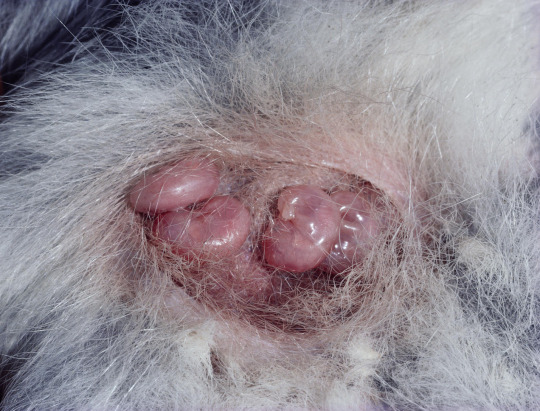
56 notes
·
View notes
Text
taking a poll. what weird mammal should i draw next:
barbourofelis fricki (bootleg smilodon)
thylacoleo carnifex (marsupial lion)
dasyurus viverrinus (eastern quoll)
machairodus lahayishupup (the real saber-toothed tiger)
hydrurga leptonyx (leopard seal)
3 notes
·
View notes
Photo
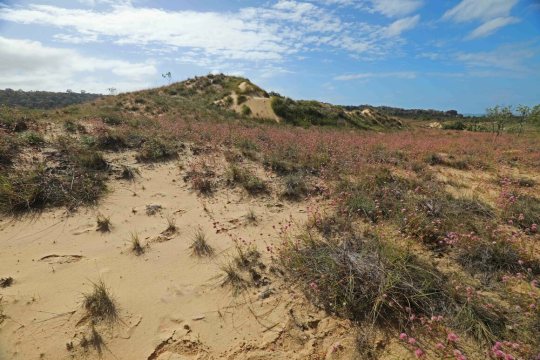
Studying Australia's Feisty Northern Quolls Requires Beef Chum and Backpacks
Australia’s northern quoll is, by all accounts, an unpleasant animal. The carnivorous marsupial, Dasyurus hallucatus, lives in isolated pockets in the country’s north and, at first glance, might be mistaken for some kind of rat or other rodent—until you notice all those sharp teeth, similar to those of a cat. Like cats, northern quolls are highly skilled nocturnal hunters, nabbing mostly insects, but also the occasional small mammal, bird, or reptile. They have an outsized reputation for “being lively and pugnacious,” says University of Queensland marsupial expert Diana Fisher. For example, in a 2018 Functional Ecology paper on northern quoll biomechanics, including the animals’ impressive bite force, the authors observed that their subjects “readily bit down on anything close to their mouths.” “We joke that they have ‘small man syndrome,’” says Joshua Gaschk, who studies animal movement at the University of the Sunshine Coast. Northern quolls are only about a foot long and max out at less than three pounds—the smallest of Australia’s four quoll species—but, says Gaschk, “They’re just an exceptionally vicious animal.” Gaschk knows from experience: He and his colleagues decided to fit several northern quolls with tiny felt backpacks. “They did not enjoy it,” he says. The backpacks carried accelerometers that collected information on how and when the quolls moved, including whether they were at rest or active. After retrieving as many of the backpacks as possible—it was “a bit of a struggle,” says Gaschk—and crunching the data, the team uncovered new clues to one of the northern quoll’s most unusual traits. But to get there, the scientists had to hike through the rugged bushland and rocky outcrops of Groote Eylandt, a large island off the coast of Australia’s Northern Territory, where daytime temps—even in winter, when the fieldwork was conducted—reached a sweltering 95 degrees Fahrenheit. The team endured biting ants, skin-shredding thorny plants, crocodiles, snakes, and packs of dingoes. And that was before they even reached their bitey, irritable subjects. Understanding how the endangered northern quoll behaves in its environment may be key to learning how to stabilize their numbers—but the team discovered something else along the way. In a recent Royal Society Open Science paper, Gaschk and his coauthors quantified for the first time something that researchers had suspected about the males of the species: During mating season, they spend significantly less time resting than females. While females rested 24 percent of their day, males took it easy a mere eight percent of the time, and instead traveled considerable distances—sometimes several miles—looking for love. Essentially, male northern quolls live fast and furious, mating as often and with as many females as they can in a single season. And then, sleep-deprived and weak, they drop dead. Northern quolls are among the handful of mammals that are semelparous, which means the males typically die after a single mating season, while the majority of females survive multiple mating seasons. “Many other animals, such as salmon, octopuses, and spiders, use semelparity as their breeding strategy,” says Julie Old, a comparative immunology and mammal biology expert at Western Sydney University who was not involved with the new paper. Old works with red-tailed phascogales, an Australian marsupial that’s much smaller than the northern quoll and, as she notes, “truly semelparous.” While scientists doing long-term studies of northern quolls occasionally come across a male who survives to a second mating season, red-tailed phascogales are decidedly one-and-done. Although semelparity in mammals is rare, Old says, “It’s just a different method of reproduction.” All or most of the males dying after mating may free up resources such as food and nesting sites for females and their offspring. In semelparous species, success for males is not measured by longevity, but rather by the number of offspring. University of Queensland’s Fisher, who was not involved in the Groote Eylandt research but works closely with some of the paper’s coauthors, compares northern quolls with another semelparous, carnivorous marsupial: antechinus, a roughly rat-sized animal whose reproductive strategies have been extensively studied. “Antechinus males try to out-mate other males rather than fighting,” Fisher says. As the antechinus males mate frantically day and night, their stress hormones and testosterone increase, they deplete their energy, their immune systems collapse, and they die from internal bleeding or infection. But, Fisher adds, “Males that die sooner are actually more successful.” While, as Fisher notes, the new paper hints at similarities in how northern quolls and antechinus males “deplete their body reserves to gain a mating advantage,” its appears unlikely that the same thing is happening physiologically in both species. The spikes in stress hormones seen in antechinus males, for example, have not been observed in northern quolls. Instead, the quolls suffer symptoms similar to those experienced by rodents in sleep deprivation studies. “I don’t think this gives us the full picture of what’s happening, but it definitely adds to the information,” Old says of the new paper. “We have so much more to learn.” The new study offers promising leads for additional research, but it’s just one facet of Gaschk’s work. In fact, the quoll semelparity paper was almost an accident. “At heart, I’m an animal biomechanist,” he says. One particular area of interest is how prey moves in relation to predators. Having just completed a similar study on feral cats, he wanted to compare their movements to those of northern quolls, which are often hunted by the felines. Logistical issues delayed the planned fieldwork until the quolls’ mating season, however, which afforded the scientists an unexpected opportunity. The Groote Eylandt research began with setting out dozens of traps, each baited with beef-flavored Chum, an Australian dog food brand. “That’s the thing the quolls love the most,” says Gaschk. He pauses, contemplative. “It’s not a great name.” Once trapped, the animals were fitted with the small felt backpacks—carefully—and then released back into the wild. The team then tried to recatch the quolls using the same method; they recovered about half of the devices, each with hours or days of data, depending on how long it took to retrap the animal. About a dozen more minipacks fell off before they could be retrieved, though one was later found by a local in her backyard. When fitting or removing the tiny packs, to avoid stressing the animals or getting bit, the team worked in pairs and kept the quolls’ faces covered as much as possible. “As soon as you cover their face, they’re like oh, I’m in a burrow, I’m okay, life’s good,” says Gaschk. He dodged being bitten during the fittings, but one northern quoll in the field gave him “a glancing bite” that he won’t soon forget: “It didn’t do much, but I felt it.” Another team member was not so lucky: A quoll bit him on the hand, with a sharp tooth “punching a hole right through the fingernail,” Gaschk says. Gaschk didn’t make it through the study unscathed, however. He recalls a particularly steep, rocky outcrop that was “a bit sketchy” climbing up, and very sketchy getting down while carrying two trapped quolls in thick, pillowcase-like bags. Gaschk slipped and landed on a young pandanus bush, which was full of sharp spines. “My hand was just shredded,” he says, recalling the pain of pulling out the embedded spines. “But I saved the animals. They didn’t get squished.” Some of the traps were set near watering holes frequented by crocodiles, and, on more than one occasion, Gaschk and his trapping partner were stalked by small packs of dingoes. “One dingo is not a threat … but two or three of them are,” he says. “It sounded like someone driving a car through the bush.” Aware of the various dangerous animals in the environment, “the biggest fright I got was in a dense bush area when I heard this thing, it sounded like someone driving a car through the bush,” Gaschk says. Crocodile? No. His smile turns sheepish. “It was just a big bandicoot,” he admits. The long-snouted marsupials reach lengths of only a couple feet, and, while they are omnivorous, they do not eat scientists. Sometimes, however, the scientists helped themselves to the local wildlife. Gaschk recalls how some field sites on the island were densely wooded with eucalypt and melaleuca, others thick with tall grasses “absolutely filled with (biting) weaver ants. “They stick onto you really well,” he adds. “They’ll be all over you when you’re out in the bush.… All of a sudden one’s creeped into a really soft spot, like under your armpit or in your groin, and starts nipping you and it really hurts.” Gaschk pauses. “They taste like limes. I was munching on them as much as they were munching on me. Just as revenge.”
https://www.atlasobscura.com/articles/australia-northern-quoll
0 notes
Photo
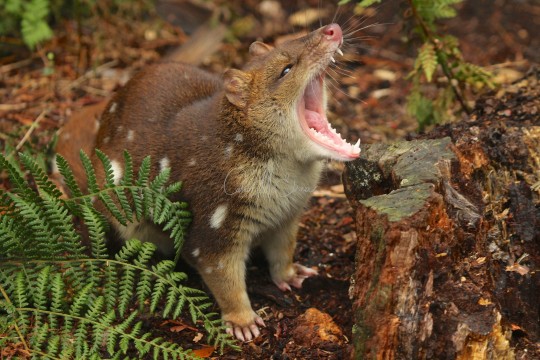
Spotted-tail quoll (Dasyurus maculatus)
Photo by Caleb McElrea
#spotted tail quoll#tiger quoll#quoll#dasyurus maculatus#dasyurus#dasyurini#dasyurinae#dasyuridae#dasyuromorphia#australidelphia#marsupialia#metatheria#mammalia#tetrapoda#vertebrata#chordata
855 notes
·
View notes